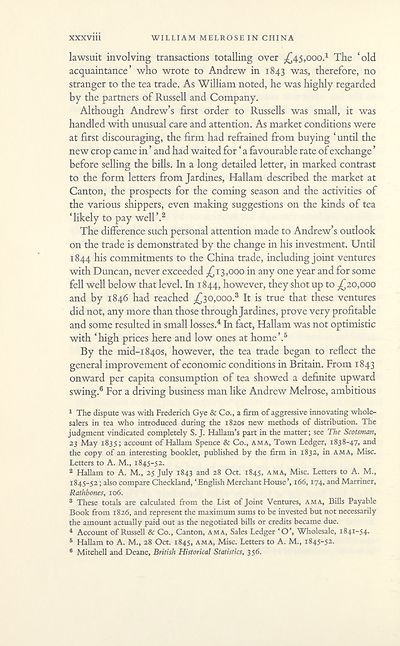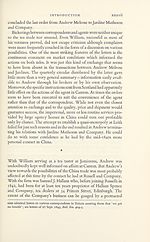Series 4 > William Melrose in China, 1845-1855
(43) Page xxxviii
Download files
Complete book:
Individual page:
Thumbnail gallery: Grid view | List view

XXXV111
WILLIAM MELROSE IN CHINA
lawsuit involving transactions totalling over .^s.ooo.1 The ‘old
acquaintance’ who wrote to Andrew in 1843 was, therefore, no
stranger to the tea trade. As William noted, he was highly regarded
by the partners of Russell and Company.
Although Andrew’s first order to Russells was small, it was
handled with unusual care and attention. As market conditions were
at first discouraging, the firm had refrained from buying ‘ until the
new crop came in ’ and had waited for ‘ a favourable rate of exchange ’
before selling the bills. In a long detailed letter, in marked contrast
to the form letters from Jardines, Hallam described the market at
Canton, the prospects for the coming season and the activities of
the various shippers, even making suggestions on the kinds of tea
‘likely to pay well’.2
The difference such personal attention made to Andrew’s outlook
on the trade is demonstrated by the change in his investment. Until
1844 his commitments to the China trade, including joint ventures
with Duncan, never exceeded ^13,000 in any one year and for some
fell well below that level. In 1844, however, they shot up to -£20,000
and by 1846 had reached £^3 0,000.3 It is true that these ventures
did not, any more than those through Jardines, prove very profitable
and some resulted in small losses.4 In fact, Hallam was not optimistic
with ‘high prices here and low ones at home’.5
By the mid-i840s, however, the tea trade began to reflect the
general improvement of economic conditions in Britain. From 1843
onward per capita consumption of tea showed a definite upward
swing.6 For a driving business man like Andrew Melrose, ambitious
1 The dispute was with Frederich Gye & Co., a firm of aggressive innovating whole¬
salers in tea who introduced during the 1820s new methods of distribution. The
judgment vindicated completely S. J. Hallam’s part in the matter; see The Scotsman,
23 May 1835; account of Hallam Spence & Co., ama, Town Ledger, 1838-47, and
the copy of an interesting booklet, published by the firm in 1832, in ama, Misc.
Letters to A. M., 1845-52.
2 Hallam to A. M., 25 July 1843 and 28 Oct. 1845, ama, Misc. Letters to A. M.,
1845-52; also compare Checkland, ‘English Merchant House’, 166,174, and Marriner,
Rathbones, 106.
3 These totals are calculated from the List of Joint Ventures, ama, Bills Payable
Book from 1826, and represent the maximum sums to be invested but not necessarily
the amount actually paid out as the negotiated bills or credits became due.
4 Account of Russell & Co., Canton, ama. Sales Ledger ‘O’, Wholesale, 1841-54.
5 Hallam to A. M., 28 Oct. 1845, ama, Misc. Letters to A. M., 1845-52.
6 Mitchell and Deane, British Historical Statistics, 356.
WILLIAM MELROSE IN CHINA
lawsuit involving transactions totalling over .^s.ooo.1 The ‘old
acquaintance’ who wrote to Andrew in 1843 was, therefore, no
stranger to the tea trade. As William noted, he was highly regarded
by the partners of Russell and Company.
Although Andrew’s first order to Russells was small, it was
handled with unusual care and attention. As market conditions were
at first discouraging, the firm had refrained from buying ‘ until the
new crop came in ’ and had waited for ‘ a favourable rate of exchange ’
before selling the bills. In a long detailed letter, in marked contrast
to the form letters from Jardines, Hallam described the market at
Canton, the prospects for the coming season and the activities of
the various shippers, even making suggestions on the kinds of tea
‘likely to pay well’.2
The difference such personal attention made to Andrew’s outlook
on the trade is demonstrated by the change in his investment. Until
1844 his commitments to the China trade, including joint ventures
with Duncan, never exceeded ^13,000 in any one year and for some
fell well below that level. In 1844, however, they shot up to -£20,000
and by 1846 had reached £^3 0,000.3 It is true that these ventures
did not, any more than those through Jardines, prove very profitable
and some resulted in small losses.4 In fact, Hallam was not optimistic
with ‘high prices here and low ones at home’.5
By the mid-i840s, however, the tea trade began to reflect the
general improvement of economic conditions in Britain. From 1843
onward per capita consumption of tea showed a definite upward
swing.6 For a driving business man like Andrew Melrose, ambitious
1 The dispute was with Frederich Gye & Co., a firm of aggressive innovating whole¬
salers in tea who introduced during the 1820s new methods of distribution. The
judgment vindicated completely S. J. Hallam’s part in the matter; see The Scotsman,
23 May 1835; account of Hallam Spence & Co., ama, Town Ledger, 1838-47, and
the copy of an interesting booklet, published by the firm in 1832, in ama, Misc.
Letters to A. M., 1845-52.
2 Hallam to A. M., 25 July 1843 and 28 Oct. 1845, ama, Misc. Letters to A. M.,
1845-52; also compare Checkland, ‘English Merchant House’, 166,174, and Marriner,
Rathbones, 106.
3 These totals are calculated from the List of Joint Ventures, ama, Bills Payable
Book from 1826, and represent the maximum sums to be invested but not necessarily
the amount actually paid out as the negotiated bills or credits became due.
4 Account of Russell & Co., Canton, ama. Sales Ledger ‘O’, Wholesale, 1841-54.
5 Hallam to A. M., 28 Oct. 1845, ama, Misc. Letters to A. M., 1845-52.
6 Mitchell and Deane, British Historical Statistics, 356.
Set display mode to:
![]() Universal Viewer |
Universal Viewer | ![]() Mirador |
Large image | Transcription
Mirador |
Large image | Transcription
Images and transcriptions on this page, including medium image downloads, may be used under the Creative Commons Attribution 4.0 International Licence unless otherwise stated. ![]()
| Scottish History Society volumes > Series 4 > William Melrose in China, 1845-1855 > (43) Page xxxviii |
|---|
| Permanent URL | https://digital.nls.uk/127695093 |
|---|
| Description | Over 180 volumes, published by the Scottish History Society, containing original sources on Scotland's history and people. With a wide range of subjects, the books collectively cover all periods from the 12th to 20th centuries, and reflect changing trends in Scottish history. Sources are accompanied by scholarly interpretation, references and bibliographies. Volumes are usually published annually, and more digitised volumes will be added as they become available. |
|---|


